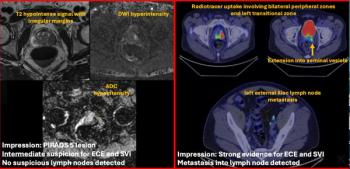
Report from ARRS: Breast MRI CAD zeroes in on malignancies
Computer-aided detection schemes for breast MR imaging have shown plenty of promise, but they always fall short of full automation and lesion characterization. Two recent studies, however, suggest CAD for breast MRI may be closing in on true cancer detection.
Computer-aided detection schemes for breast MR imaging have shown plenty of promise, but they always fall short of full automation and lesion characterization. Two recent studies, however, suggest CAD for breast MRI may be closing in on true cancer detection.
Investigators presented results of a study featuring the ONCAD automated breast cancer detection system for contrast-enhanced MRI. They used fat-suppressed T1-weighted MR images of 102 biopsy-proven breast cancers and 131 cancer-free breasts from six major U.S. research institutions.
The researchers - from Penn Diagnostics, a breast MRI CAD company based in Rockville, MD, and George Washington University - found that ONCAD could identify up to 96% of true malignancies on contrast-enhanced MRI. They released preliminary results Tuesday at the American Roentgen Ray Society meeting in Washington, DC.
The investigators used a quantitative measure (blooming) for the assessment of lesion morphology and conspicuity. Morphological blooming measures changes in the sharpness of lesion margins. The deterioration in margin sharpness during a few minutes of imaging suggests malignancy.
The ability of morphological blooming measurements to discriminate between benign and malignant lesions can be evaluated with free-response ROC analysis. It sets numerical thresholds for evaluating imaging sensitivity as a function of the number of false positives.
Researchers evaluated three different thresholds (blooming 7, 9, and 10) used in previous studies, which led to true- and false-positive rates of 96.1% and 6.6% (blooming 7), 92.1% and 4.3% (blooming 9), and 86.3% and 3.5% (blooming 10).
Lead investigator and presenter Alan Penn, Ph.D., pointed out that many false positives stem from vessels, artifacts, fibrocystic disease, and other benign conditions that remain an obstacle to CAD's clinical acceptance. Additional studies should validate results on independent data sets and develop ways of reducing false positives, he said.
"A very large percentage of those things are obvious false positives and have no clinical significance," Penn said. "But we don't have a way to measure them at this point."
In another study, researchers from New York University and Siemens Medical Solutions presented results of a computer classification system designed to improve the BI-RADS classification of breast MRI results.
The researchers retrospectively reviewed data sets from 40 patients who underwent breast MRI at NYU. Three radiologists blinded to results evaluated 75 lesions (28 malignant, 47 benign) and determined BI-RADS ratings. The investigators then used a computer classification system that calculated risk factors for each interpretation and respectively upgraded or downgraded each BI-RADS rating.
The investigators found the automated classification tool yielded more accurate BI-RADS classifications than the three radiologists. The technique improved the evaluation of BI-RADS 3 lesions, missed fewer cancers, and correctly classified benign lesions as BI-RADS 2.
A larger study is required to validate these preliminary results, according to coauthor Linda Moy, a radiologist at NYU. She remarked to the audience, however, that this system is not a CAD system in the conventional sense of the term.
For more information from the Diagnostic Imaging archives:
Newsletter
Stay at the forefront of radiology with the Diagnostic Imaging newsletter, delivering the latest news, clinical insights, and imaging advancements for today’s radiologists.




























